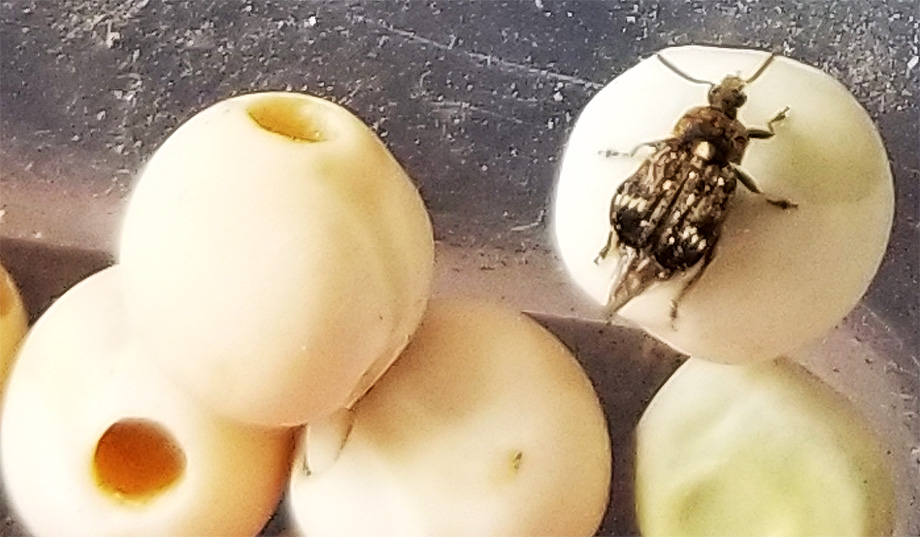Pea Weevils
Family name: Curculionidae
Latin name: Bruchus pisorum
Description: Pea weevils are members of the beetle order (Coleoptera) and are found all over the world, causing significant damage to pea crops. They have chunky, black to brown bodies with mottled backs and an extended head, called a rostrum. They are able to fly up to 3 miles (5 km) which makes them challenging to control. The larvae are the most damaging stage of their life cycle because they burrow into the pods and feed on the young peas. The adult weevils also cause damage by feeding on the pea flowers, potentially affecting plant productivity. The adults are about 1/5-inch (5 mm) long and the larvae ¼-inch (6 mm) long. The eggs are yellowish-brown in color and cigar-shaped. There is a similar insect called the pea leaf weevil (Sitona lineatus), but it only feeds on the leaves of pea plants.
Life cycle: Adult pea weevils overwinter in plant debris, then emerge in the spring. After feeding on the pollen in pea flowers, they mate and the females lay eggs on the pea pods. Once the eggs hatch, the larvae burrow into the pods and then feed on the young peas. There will only be one larva per pea seed. After about 40 days, they exit the pea and pupate for 14 days in late summer although will sometimes will remain inside the pea seed through the winter. They will emerge as an adult the following spring. There is only one generation per year.
Typically seen on: Peas, fava beans and other broad beans.
Signs of their activity: Holes in individual peas.
Natural predators: Beneficial nematodes, birds, ground beetles, spiders.
Organic controls:
- Check seeds for any small holes indicating potential presence of larvae.
- Cover planting bed with floating row cover until plants are ready to bloom.
- Closely monitor pea patch as soon as the plants begin blooming.
- Sprinkle diatomaceous earth around the base of pea seedlings to create one type of a barrier to the weevils.
- Hand-pick any weevils you find.
- Clean up and dispose of pea crop debris (do not compost!).
- At the end of the garden season, cultivate the top 2 inches of soil in the pea bed to expose pupae or overwintering larvae to cold winter temperatures, the elements, and predators.
- Pyrethrins are listed as a possible organic control, but be aware this spray will also kill beneficial insects, is highly toxic to bees, and aquatic life. If you decide to use it, follow label directions to the letter, apply the spray when pollinators aren’t active (very early morning or late in the day), and do not apply near or around flowers (this includes when your pea planting are blooming).
- If pea weevils were a problem in your previous year’s garden, don’t grow peas or fava beans for a couple of years.
- NOTE: My research indicated that another potential control was to plant pea varieties that are resistant to pea weevils. However, I was not able to locate any sources for these seeds.
Back to Organic Pest Control

